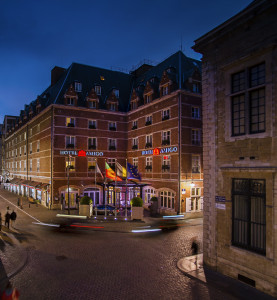
The cover of one of the most popular Tintin books.
When my son, Grael, was a child, I used to read “The Adventures of Tintin“ books to him nearly every night.
For those of you who don’t know about Tintin, he was a brilliantly drawn cartoon character created by the Belgian artist Hergé, a boy reporter who, along with his faithful dog Snowy and hard-drinking, foul-mouthed sidekick Captain Haddock, solved mysteries in exotic locales around the globe.
Besides outsmarting and outfighting dastardly villains, he had to overcome the interference of two bumbling detectives, Thompson and Thomson, who looked exactly alike and were equally incompetent, and deal with eccentric figures like hearing-impaired Professor Calculus and operatic diva Bianca Castafiore.
Tintin was always getting into and then escaping from life-threatening situations, and the colorful illustrations, reflecting a world that pre-dated mass tourism, made everything foreign — from Egypt to Tibet, Latin America to Russia — seem exciting, strange (in a good way) and alluring.
(On the negative side, colonial-era stereotypes abounded; Hergé himself seldom left Belgium, so his depictions mostly reflected his fertile mind and pen and the prevailing notions of the day; Tintin debuted in 1929.)
Grael collected all the books that were in print in English — two dozen of them — and still keeps Tintin posters on his wall as an adult. In many ways, Tintin books defined his literary life as a young child, and my role as father as well, which was in part to nurture his imagination and love of geography, adventure, reading and writing. They certainly helped fuel a thirst for travel in both of us.
So when I read about a hotel in Brussels offering a year-round “Following in the Footsteps of Tintin” package for families, allowing them to retrace some of the landmark locations in the books, I was ready to book a flight to Belgium and check in — son in tow, of course, even if he’s now married and grown.
“Families” can include grandparents and their grandchildren, I would note, especially since it was Grael’s grandmother who first introduced him to Tintin when she brought him back a book — Tintin en Amerique — from France, then translated it for him into English. Like many Americans, I had never heard of Tintin back then, though he was wildly popular in Europe — more than 350 million copies of his books have been sold — and he has since been the subject of a Steven Spielberg movie.
The hotel offering the Tintin package is the Hotel Amigo, located in the heart of Brussels near a giant Tintin wall mural on the Rue de L’Etuve and the Tintin Boutique at 13 Rue de Colline near the Grand Place, Brussels’ historic central square. (The hotel even outfitted a couple of Tintin-themed suites in conjunction with the Spielberg film in late 2011.)
Because Tintin lived in Brussels, a fair amount of the action in the books takes place there. The Tintin Trail includes a walk through the Brussels park depicted in the book King Ottokar’s Sceptre, a visit to the concert hall that inspired the Hippodrome in The Seven Crystal Balls, and a chance to browse through antiques at the daily flea market on the Place du Jeu de Balle, where Tintin found an old model ship that led him off in search of Red Rackham’s Treasure (and served as the setting for the opening scene in Spielberg’s film).
Besides a Tintin map of Brussels and a Tintin book, the package comes with a Snowy stuffed animal and four tickets (two adults, two children) to the Hergé Museum, located about a half hour outside Brussels in Louvain-la-Neuve. Shuttles are available from the hotel, or you can take the train.
The museum showcases original print plates and drawings, photos, documents, and interviews with Hergé, whose body of work actually extended well beyond Tintin, though the latter is the big draw.
Not part of the package, but a good stop for Tintin fans, is the Belgian Centre for Comic Strip Art, where you’ll learn more about the boy reporter and his creator, as well as other Belgian cartoons, including the Smurfs.
A bonus: besides cartoons, Belgium has some of the best beer, chocolate, French fries, mussels and waffles in the world. It’s been one of my favorite countries since well before I ever discovered The Adventures of Tintin, but the latter puts it over the top.













Leave a Reply